|  
 
 | | | | 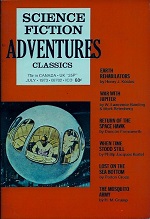 The first story also appeared in this July 1973 reprint magazine. The first story also appeared in this July 1973 reprint magazine. | | The Time Control Stories
by Philip Jacques Bartel
First story: Amazing, Feb 1935

Two Russians (Khalin and Mikhailloff) and an American engineer (Earl Lyons) find a way to step outside of time, view the future, then step back into time at the very point that they left, thereby preventing bad things such as Mikhailloff’s murder (in “When Time Stood Still,” Amazing, Feb 1935) and an insult that’s intended to start a war (“The Time Control,” Amazing, Dec 1936). | |
| | | | |

 
 | | | | 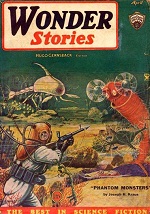 | | “The Prophetic Voice”
by Laurence Manning
First publication: Wonder Stories, Apr 1935

A voice, purporting to be from the future, warns mankind that they must all go into suspended animation or face extinction; mankind obeys, but when they wake up, the people at the other end of the future phone don’t know anything about the earlier message. | |
| | | | |

 | | | | 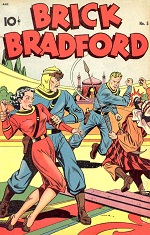 Brick Bradford #5, Brick Bradford #5,
Jul 1948

| | Brick Bradford
by William Ritt and Clarence Gray
First time travel: 20 Apr 1935

Ritt and Gray introduced The Time Top as a short-lived separate topper strip on April 20/21, 1935, and it first appeared in Brick’s Sunday strip on Oct 17, 1937; thereafter, it frequently took the comic strip adventurer into the future (and occasionally the past).

Brick’s strips were reprinted as early as 1934 with two hardcover issues of Saalfield Comics (#1059 and #1309). He was reprinted in King Comics starting with the first April 1936 issue, and he headlined one 1938 hardcover Big Little Book (#1468, combining text with line illustrations). Some Ace Comics had reprints (1947-49), and he appeared in four issues of his own comic book: #5 (Jul 1948) to #8 (Jul 1949) that were possibly strip reprints. In the 60s, new Brick backup features appeared in some issues of The Phantom, Mandrake the Magician (at least #5, #6 and #10) and Flash Gordon (at least #14, #16, #17). They probably all used the top, but I don’t know for sure. All that was just in the U.S.: He was vastly more popular in Australia and New Zealand. Into the past . . . into the future . . . read on for another exciting adventure in time with Brick Bradford Into the past . . . into the future . . . read on for another exciting adventure in time with Brick Bradford 

—Brick Bradford and the Time Top 25, Australia
| |
| | | | |

 | | | | 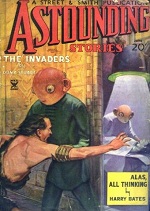

| | “Alas, All Thinking”
by Harry Bates
First publication: Astounding, Jun 1935

Charles Wayland is tasked with discovering why his cold-hearted college buddy and all-around genius (I.Q. 248) physicist Harlan T. Frick has abandoned everything technical for mundane pursuits such as golfing, clothes, travel, fishing, night clubs, and so on—and the explanation may have to do with either Humpty Dumpty or Frick’s trip to the future with an average (but meditative) young woman named Pearl who is most curious about love. I showed her New York. She’d say, “But why do the people hurry so? Is it really necessary for all those automobiles to keep going and coming? Do the people like to live in layers? If the United States is as big as you say it is, why do you build such high buildings? What is your reason for having so few people rich, so many people poor?” It was like that. And endless. I showed her New York. She’d say, “But why do the people hurry so? Is it really necessary for all those automobiles to keep going and coming? Do the people like to live in layers? If the United States is as big as you say it is, why do you build such high buildings? What is your reason for having so few people rich, so many people poor?” It was like that. And endless. 
| |
| | | | |

 | | | | 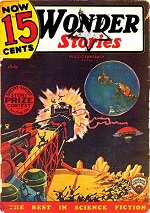 | | “A Thief in Time”
by Vernon H. Jones (as by Raymond A. Young)
First publication: Wonder Stories, Jul 1935

A scientist sends gangster Tony Carponi to steal some radium, and only years later does Carponi realized that the caper involved time travel. | |
| | | | |

 
 | | | | 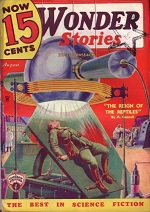 | | “The Branches of Time”
by David R. Daniels
First publication: Wonder Stories, Aug 1935

James Bell invents a time machine, sees the end of mankind in the near future, travels further to see man’s successor, returns to mankind’s end to save the species, and visits the Mesozoic, anticipating Bradbury’s Butterfly Effect. | |
| | | | |

 | | | | 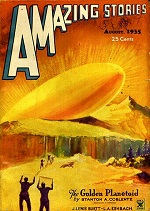 | | “The Kingdom of Thought”
by Lloyd Arthur Eshbach
First publication: Amazing, Aug 1935

Donald Stile is transported to the future by a Time Sphere where he finds two groups of giant brains (the good white brains and the evil black brains) battling—but what of the grey brain? | |
| | | | |

 | | | | 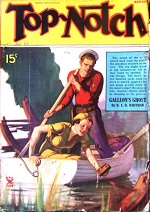 | | “The Man Who Met Himself”
by Ralph Milne Farley
First publication: Top-Notch, Aug 1935

Among physicists, the most favored resolution to time-travel paradoxes is a world of one fixed landscape of time and its events. Time travel may be possible, but if so, the Karma will conspire to have only those events that have been written into the landscape to occur. Heinlein’s “—All You Zombies—” may be the pinnacle of such stories, but Farley’s is the earliest case that I’ve read to present a clear deterministic time loop along these lines. In the story, Boston stock broker Dick Withrick is on a 1935 tiger hunt in Cambodia when he runs into a strangely familiar (and slightly older) man who warns him, “As you value your freedom, do not touch the machine—” And yet, he does touch the machine, taking him back to 1925 so he (in the company of his Buddhist Abbot host) can relive the decade of financial turmoil. “It cannot be,” the Abbot asserted suavely. “The years from 1925 to 1935 happen only once in the whole course of eternity. You are not now living through a repetition of those ten years. Rather it is those same ten years. The events which you remember as having happened back in Boston, and the events which are happening here today, are happening simultaneously. Your ten years in Boston from 1925 to 1935, are one and the same ten years. It is only an illusion of your mind that they seem to be successive, rather than concurrent. And this illusion is not so different from the illusion of all mankind with respect to the flow of timel for Brahm, the Creator, sees all time and all space as once complete instantaneous event.” “It cannot be,” the Abbot asserted suavely. “The years from 1925 to 1935 happen only once in the whole course of eternity. You are not now living through a repetition of those ten years. Rather it is those same ten years. The events which you remember as having happened back in Boston, and the events which are happening here today, are happening simultaneously. Your ten years in Boston from 1925 to 1935, are one and the same ten years. It is only an illusion of your mind that they seem to be successive, rather than concurrent. And this illusion is not so different from the illusion of all mankind with respect to the flow of timel for Brahm, the Creator, sees all time and all space as once complete instantaneous event.” 
| |
| | | | |

 | | | | 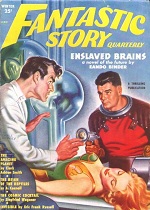 This story was reprinted in the Winter 1951 issue of Fantastic Story Quarterly This story was reprinted in the Winter 1951 issue of Fantastic Story Quarterly | | “The Reign of the Reptiles”
by Alan Connell
First publication: Wonder Stories, Aug 1935

Sanders is kidnapped and sent to a laboratory in the far past from which he escapes to find a civilization of intelligent, winged reptiles—possibly the first story of intelligent dinosaurs in our past. | |
| | | | |

 | | | | 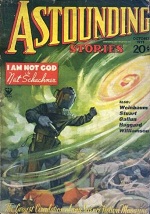

| | “Night”
by John W. Campbell, Jr. (as by Don A. Stuart)
First publication: Astounding, Oct 1935

Bob Carter takes a plane up to 45,000 feet to test an anti-gravity device, but instead it hurls him into the same future as the story “Twilight”—but whereas the earlier story had mankind who were dying out in 7,000,000 A.D. because of the ubiquity of machines, Carter finds himself billions of years beyond that, with both man and (most) machines long gone. Ah, yes, you have a mathematical means of expression, but no understanding of that time, so it is useless. But the last of humanity was allowed to end before the Sun changed from the original G-O stage—a very, very long time ago. Ah, yes, you have a mathematical means of expression, but no understanding of that time, so it is useless. But the last of humanity was allowed to end before the Sun changed from the original G-O stage—a very, very long time ago. 
| |
| | | | |

 
 | | | | 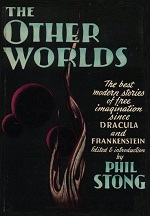 The story also appeared in Phil Stong’s 1941 anthology, The Other Worlds. The story also appeared in Phil Stong’s 1941 anthology, The Other Worlds. | | “The Fourth-Dimensional Demonstrator”
by Murray Leinster
First publication: Astounding, Dec 1935

Pete Davidson has inherited all the properties of an uncle who had been an authority on the fourth dimension, including the Fourth-Dimensional Demonstrator that can pull copies of matches, coins, dollar bills, fiancées and kangaroos out of the past. It’s produced another burnt match. Dragged it forward out of the past, sir. There was a burnt match at that spot, until the glass plate moved a few seconds ago. Like the girl and the banana peel, sir. The machine went back to the place where the match had been, and then it went back in time to where the match was, and then it brought it forward. It’s produced another burnt match. Dragged it forward out of the past, sir. There was a burnt match at that spot, until the glass plate moved a few seconds ago. Like the girl and the banana peel, sir. The machine went back to the place where the match had been, and then it went back in time to where the match was, and then it brought it forward. 
| |
| | | | |

 | | | | 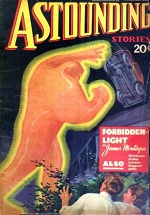 | | “Human Machines”
by J. Harvey Haggard
First publication: Astounding, Dec 1935

When the megalomanic and utopia-builder Lan Darth is opposed by Therm Sutner, Darth throws Sutner into a horrid future world that is populated by strange creatures that arose out of Darth’s eugenic and policies that banned sexual reproduction. | |
| | | | |

 | | | | 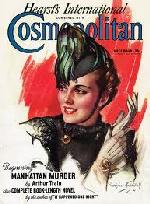

| | “Time Found Again”
by Mildred Cram
First publication: Cosmopolitan, Dec 1935

Bart Henderson hates his life in 1935, longing for a daughter without painted fingernails and curled coxcombs, a son without bloodshot eyes at the breakfast table, a wife less jaded. Then his army buddy visits and suggests that nothing is ever lost in time, and it might be possible for the human mind to tear off the veils and return to a time such as the 18th century that Bart longs for.

It was fun to see both the advertisements and the innovation of Cosmopolitan to publish a time-travel story by the prolific Mildred Cram in 1935. The style reminds me of later Jack Finney stories of the 50s. He ran a few steps forward in the dark, stumbling. The syncopated, thudding hoofbeats broke rhythm, paused . . . And Bart Henderson found himself, in broad daylight, standing beside a fine carriage driven by a coachman in livery, drawn by two black horses with silver-trimmed harness. He ran a few steps forward in the dark, stumbling. The syncopated, thudding hoofbeats broke rhythm, paused . . . And Bart Henderson found himself, in broad daylight, standing beside a fine carriage driven by a coachman in livery, drawn by two black horses with silver-trimmed harness. 
| |
| | | | |

No Time Travel. Move along. |
“The 32nd of May” by Paul Ernst, Astounding, Apr 1935 [parallel universes ]

“Relativity to the Rescue” by J. Harvey Haggard, Amazing, Apr 1935 [ftl ]

“The Worlds of If” by Stanley Weinbaum, Wonder Stories, Aug 1935 [viewing alternate pasts ]

“The Fourth-Dimensional Demonstrator” by Murray Leinster, Astounding, Dec 1935 [despite title, no time travel ]

| |     |